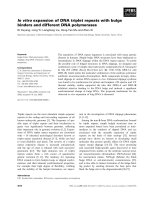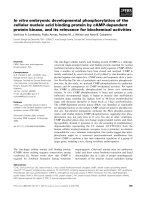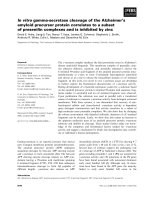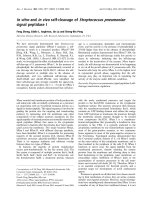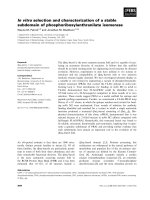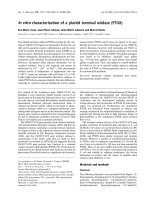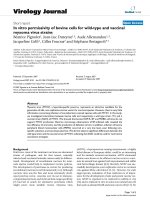Báo cáo sinh học: "In vitro susceptibilities of Brucella melitensis isolates to eleven antibiotics" pptx
Bạn đang xem bản rút gọn của tài liệu. Xem và tải ngay bản đầy đủ của tài liệu tại đây (217.04 KB, 4 trang )
BioMed Central
Page 1 of 4
(page number not for citation purposes)
Annals of Clinical Microbiology and
Antimicrobials
Open Access
Research
In vitro susceptibilities of Brucella melitensis isolates to eleven
antibiotics
Aun Turkmani
†1
, Alexandros Ioannidis
†1
, Athanasia Christidou*
1
,
Anna Psaroulaki
1
, Feidias Loukaides
2
and Yiannis Tselentis
1
Address:
1
Department of Clinical Bacteriology, Parasitology, Zoonoses, and Geographical Medicine, Faculty of Medicine, University of Crete,
Greece and
2
Veterinary services of Cyprus, Athalassa, Nicosia, Cyprus
Email: Aun Turkmani - ; Alexandros Ioannidis - ; Athanasia Christidou* - ;
Anna Psaroulaki - ; Feidias Loukaides - ; Yiannis Tselentis -
* Corresponding author †Equal contributors
Abstract
Background: Brucellosis is an endemic disease present in many countries worldwide, but it is rare
in Europe and North America. Nevertheless brucella is included in the bacteria potentially used for
bioterrorism. The aim of this study was the investigation of the antibiotic susceptibility profile of
brucella isolates from areas of the eastern Mediterranean where it has been endemic.
Methods: The susceptibilities of 74 Brucella melitensis isolates derived from clinical samples (57)
and animal products (17) were tested in vitro. The strains originate from Crete (59), Cyprus (10),
and Syria (5). MICs of tetracycline, rifampicin, streptomycin, gentamicin, norfloxacin, ciprofloxacin,
levofloxacin, trimethoprim/sulfamethoxazole, ampicillin, amoxicillin/clavulanic acid, and
erythromycin were detected by E-test method. The NCCLS criteria for slow growing bacteria
were considered to interpret the results.
Results: All the isolates were susceptible to tetracycline, streptomycin, gentamicin, ciprofloxacin,
norfloxacin, and levofloxacin. Two isolates presented reduced susceptibility to rifampicin (MIC
value: 1.5 mg/l) and eight to SXT (MIC values: 0.75–1.5 mg/l). Erythromycin had the highest (4 mg/
l) MIC
90
value and both norfloxacin and erythromycin the highest (1.5 mg/l) MIC
50
value.
Conclusion: Brucella isolates remain susceptible in vitro to most antibiotics used for treatment
of brucellosis. The establishment of a standardized antibiotic susceptibility method for Brucella spp
would be useful for resistance determination in these bacteria and possible evaluation of
bioterorism risks.
Background
Brucella is a pathogen of global dispersal, which affects
both humans and animals. This dispersal has exhibited a
shift towards the Asian countries; on the contrary there is
a significant reduction in brucellosis cases, in countries
where brucellosis was endemic in the past such as Spain
and Italy [1]. At the moment brucellosis is scarce in West-
ern Europe and North America since effective public
health measures have been established, however such
countries are considering Brucella to be a potential bioter-
Published: 02 October 2006
Annals of Clinical Microbiology and Antimicrobials 2006, 5:24 doi:10.1186/1476-0711-5-
24
Received: 05 July 2006
Accepted: 02 October 2006
This article is available from: />© 2006 Turkmani et al; licensee BioMed Central Ltd.
This is an Open Access article distributed under the terms of the Creative Commons Attribution License ( />),
which permits unrestricted use, distribution, and reproduction in any medium, provided the original work is properly cited.
Annals of Clinical Microbiology and Antimicrobials 2006, 5:24 />Page 2 of 4
(page number not for citation purposes)
rorism threat leading to an increased interest in those
countries [2].
Brucella is an intracellular bacterial pathogen that infects
host macrophage cells. In consequence, specialized agents
that are able to penetrate the macrophages and function
within their cytoplasm are required for the treatment of
brucellosis. Tetracyclines, rifampicin, trimethoprim-sul-
phamethoxazole (SXT), streptomycin, and other
aminoglycosides, separately or in combinations, are most
commonly used for brucellosis treatment [3,4]. Fluoro-
quinolones, and macrolides may serve as an alternative
drug choice [5,6]. In 1986, the WHO has released recom-
mendations for use of doxycycline, combined with either
rifampicin or streptomycin for treating human brucello-
sis. This recommendation is still in function.
Brucella isolates are generally considered susceptible to
the recommended by the WHO antibiotics. Nevertheless
sporadic cases of a kind of antibiotic resistance have been
reported [7,8]. The aim of this essay was to determine the
antibiotic susceptibilities of the Brucella isolates identified
in the Laboratory of Clinical Bacteriology, Parasitology,
Zoonoses, and Geographical medicine of the University of
Crete.
Methods
A number of 74 strains were included in this research both
of human and animal origin. The human samples were
cultured using the automated blood culture system (Orga-
non Teknika BacT/Alert, Biomerieux
®
, France) and the ani-
mal strains were isolated using Brucella selective culture
media. Typing of all Brucella isolates was based on con-
ventional microbiological methods (the requirement of
CO
2
for growth, production of urease and H
2
S, sensitivity
to the dyes basic fuchsin and thionin, and lysis by the
phages Tiblissi and Weybridge).
In addition to the 74 strains, 6 Brucella reference strains:
B. abortus 104 M, B. abortus 2308, B. melitensis 16 M bio-
type 1 (ATCC 23456), B. abortus B3196 biotype 5 (ATCC
23452), B. suis 513 biotype 5, and B. neotomae 5K33
(ATCC 23459) were also tested. The reference strains:
Esherichia coli ATCC 25922, Staphylococcus aureus ATCC
29213 were used as control.
Antibiotic susceptibility testing was performed by the E-
test method (AB biodisk) according to the manufacturer's
guidelines. The 11 antibiotics tested were: tetracycline,
rifampicin, streptomycin, gentamicin, norfloxacin, cipro-
floxacin, levofloxacin, trimethoprim/sulfamethoxazole,
ampicillin, amoxicillin/clavulanic acid, and erythromy-
cin. The bacterial suspension, in a concentration equal to
10
5
– 10
6
cfu/ml, was inoculated on Mueller Hilton agar
plates, supplemented with 5% sheep blood agar, and the
E- test strips were applied. The plates were incubated at
35°C in a 5% CO
2
atmosphere for 48 h.
The NCCLS interpretive criteria for slow growing bacteria
(Haemophilus) were also taken into consideration in
order to evaluate the results of MICs determination [9].
Results
The analysis of the data concerning the isolates resulted in
the following. All isolates are from the time period 1999–
2005 and originate from various regions of the Eastern
Mediterranean (Crete, 59; Cyprus, 10; and Syria, 5).
Seventeen isolates were obtained from sick animals
(sheep and goats); the source of isolation was animal
products, mainly milk. The remaining 57 isolates origi-
nate from patients (Table 1). Amongst the 55 patients
from Crete, 5 were immigrants from the Balkan area,
recently immigrated and were therefore possibly infected
in their prior settlements. In additional, four of the
patients were in relapse while the rest were in acute phase.
The clinical isolates were obtained from blood (44), bone
marrow (3), synovial fluid (2), cerebrospinal fluid (1),
bone tissue (2), and juxtaspinal abscess (1).
All isolates were identified as Brucella melitensis.
The MIC
50
and MIC
90
values of the antibiotics are shown
in Table 2. The MIC values of tetracycline, ciprofloxacin,
levofloxacin, and amoxicillin/clavulanic acid, interpreted
according to the NCCLS criteria for slow growing bacteria,
have shown ranges below the breakpoints for sensitivity
determination. The MIC values of ampicillin, rifampicin,
and SXT range at levels below the breakpoints for resist-
ance determination. The MIC of rifampicin is 1.5 mg/l for
two isolates and the MIC values of SXT range from 0.75
mg/l to 1.5 mg/l for eight of the isolates. The MICs of
Table 1: Distribution of human and animal derived Brucella melitensis isolates by geographical location
Geographical Location Human Origin (No) Animal Origin (No) Total (No)
Crete (Greece) 55 4 59
Cyprus 2 8 10
Syria 55
Total 57 17 74
Annals of Clinical Microbiology and Antimicrobials 2006, 5:24 />Page 3 of 4
(page number not for citation purposes)
streptomycin and gentamicin were also low. The erythro-
mycin among the total of the antibiotics and the nor-
floxacin among the quinolones presented the highest MIC
values.
Furthermore, no kind of resistance was detected in the iso-
lates derived from patients in relapse and their MIC values
were at low levels.
Discussion
Brucella species are highly infectious pathogens and level 3
biosafety precautions must be kept during the susceptibil-
ity testing procedure. These pathogens are considered to
be susceptible to the antibiotics recommended by the
WHO for treatment of brucellosis. Subsequently, Brucella
susceptibility testing is not routinely performed. Addi-
tionally, there is no standardized method for susceptibil-
ity testing recommended by NCCLS for these
microorganisms. Relapses, at a rate of about 10 percent,
usually occur in the first year after the infection, but they
are caused by inadequate treatment in most cases [3].
Antibiotic-resistant Brucella strains are rarely a cause of
therapy failure [4]. However, strains resistant to the main
antimicrobial agents may emerge [10] and lead on to
treatment inhibition.
There are few reports for the in vitro susceptibilities of Bru-
cella and various methodologies have been applied. Broth
microdilution [11-13], agar dilution [5,14], and E-test
methods [7,13,15] have been applied for antibiotic MIC
determinations. Brucella agar [11], Muller-Hinton agar,
and Muller-Hinton broth supplemented with 1% Polyvi-
tex [12-14], or combined 1% Polyvitex and 1% haemo-
globin [5], and Muller-Hinton agar supplemented with
5% sheep blood agar [7,13] are the media used for antibi-
otic susceptibility testing of Brucella. E-test is a reliable,
reproducible, and easily performed method for antimicro-
bial susceptibility testing and has been successfully
employed for the testing of Brucella strains [7,13,14].
The isolates included in this study, originated from three
Eastern Mediterranean countries (Greece, Cyprus, and
Syria) and were highly susceptible to most antibiotics
tested, which is consistent with previous reports. Tetracy-
cline (MIC90: 0.5 mg/l) was proved to be active in vitro
against all the isolates; this finding agrees with previous
reports [7,11,14,15]. Rifampicin (MIC90: 1) also exhib-
ited good activity. However two of the total (74) isolates
were inhibited by 1.5 mg/l of rifampicin. Since break-
points have not yet been established for Brucella species,
these strains cannot be confidently characterised as of
intermediate resistance, although a reduced susceptibility
may exist. MIC values of rifampicin ranging from 1 to 4
mg/l have already been reported [7,8]. A similar result was
obtained for SXT. Eight of the 74 isolates with MIC values
from 0.75 to 1.5 mg/l may be characterized as intermedi-
ate resistance strains according to the NCCLS interpretive
criteria for slow growing bacteria. Significant rates of SXT
resistance have been reported in previous studies [7,8].
MICs of aminoglycosides (streptomycin, and gentamicin)
were low, corresponding to in vitro susceptibility of all
isolates, which is consistent with previous reports [6,11].
Several studies focused on quinolones activity against Bru-
cella, because these agents appeared as an attractive alter-
native drug choice for human brucellosis treatment.
Although in vitro resistance to quinolones is not high, the
effectiveness of these antibiotics remains controversial
[5,6,11,12]. Our isolates were inhibited in vitro by low
concentrations of quinolones.
The role of macrolides in brucellosis treatment also
remains controversial [5,6]. MIC values of erythromycin
ranged from 0.5 to 8 mg/l, indicating reduced activity.
Table 2: In vitro susceptibilities of Brucella melitensis isolates to 11 antibiotics
Antibiotics Range (mg/l) MIC50 (mg/l) MIC90 (mg/l)
Tetracycline 0.032 – 1.5 0.125 0.5
Rifampicin 0.094 – 1.5 0.5 1
Streptomycin 0.125 – 4 1 2
Gentamicin 0.032–1.5 0.19 2
Norfloxacin 0.125 – 4 1.5 3
Ciprofloxacin 0.016 – 0.75 0.19 0.5
Levofloxacin 0.064 – 0.75 0.25 0.5
Trimethoprim/
sulfamethoxazole
0.032/0.61 – 1.5/28.5 0.125/2.38 0.75/14.2
Ampicillin 0.094 – 3 0.75 2
Amoxicillin/clavulanic acid 0.032 – 1.5 0.38 1
Erythromycin 0.5 – 8 1.5 4
Publish with BioMed Central and every
scientist can read your work free of charge
"BioMed Central will be the most significant development for
disseminating the results of biomedical research in our lifetime."
Sir Paul Nurse, Cancer Research UK
Your research papers will be:
available free of charge to the entire biomedical community
peer reviewed and published immediately upon acceptance
cited in PubMed and archived on PubMed Central
yours — you keep the copyright
Submit your manuscript here:
/>BioMedcentral
Annals of Clinical Microbiology and Antimicrobials 2006, 5:24 />Page 4 of 4
(page number not for citation purposes)
Erythromycin, ampicillin, and amoxicillin/clavulanic acid
were included in the study for research purposes only, as
those agents are ineffective in vivo for brucellosis treat-
ment. Subsequently, the low MIC values of ampicillin and
amoxicillin/clavulanic acid found in our isolates do not
correspond to any therapeutic effect.
Conclusion
Brucellosis remains a major public health problem in
countries with low socialeconomical status. The necessity
to keep rifampicin for tuberculosis treatment and the
requirement of alternative drug therapy for specialized
cases entails the research for other antibiotic usage. Subse-
quently, the antibiotic susceptibility testing of Brucella
may help the choice of treatment in specific cases, the epi-
demiological surveys and the prediction pottential
threats. Therefore, the establishment of a simple, reliable,
and low-costing method for Brucella susceptibility testing
would be useful for an early detection of any drug resist-
ance that may be developed.
Competing interests
The author(s) declare that they have no competing inter-
ests.
Authors' contributions
AT carried out the acquisition, analysis and interpretation
of the data. AI performed the computation analysis of the
study and critically revised the manuscript. AC performed
the analysis and interpretation of the data and drafted the
manuscript. FL contributed in acquisition of data. AP and
YT carried out the design and coordination of the study.
All authors read and approved the final manuscript.
Acknowledgements
The authors wish to thank Eleni Tzani for her assistance in laboratory tech-
nical procedures of the study.
References
1. Pappas G, Papadimitriou P, Akritidis N, Christou L, Tsianos EV: The
new global map of human brucellosis. Lancet Infect Dis 2006,
6:91-99.
2. Bossi P, Tegnell A, Baka A, Van Loock F, Hendriks J, Werner A, Maid-
hof H, Gouvras G, Task Force on Biological and Chemical Agents
Threats, Public Health Directorate, European Commission, Luxem-
bourg: Bichat guidelines for the clinical management of bru-
cellosis and bioterrorism-related brucellosis. Euro Surveill
2004, 15(9(12)):E15-16.
3. Pappas G, Akritidis N, Bosilkovski M, Tsianos E: Brucellosis. N Engl
J Med 2005, 352:2325-2336.
4. Hall WH: Modern chemotherapy for brucellosis in humans.
Rev Infect Dis 1991, 13(3):523-524.
5. Garcia-Rodriguez JA, Garcia-Sanchez JE, Trujillano I: Lack of effec-
tive bactericidal activity of new quinolones against Brucella
spp. Antimicrob Agents Chemother 1991, 35:756-759.
6. Qadri SM, Halim MA, Ueno Y, Abumustafa FM, Postle AG: Antibac-
terial activity of azithromycin against Brucella melitensis.
Chemotherapy 1995, 41(4):253-256.
7. Baykam N, Esener H, Ergonul O, Eren S, Celikbas AK, Dokuzoguz B:
In vitro antimicrobial susceptibility of Brucella species. Intern
J Antimicrob Agents 2004, 23:405-407.
8. Lopez-Merino A, Contreras-Rodriguez A, Migranas-Ortiz R, Orran-
tia-Gradin R, Hernandez-Oliva GM, Guttierrez-Rubio AT, Cardenosa
O: Susceptibility of Mexican brucella isolates to moxi-
floxacin, ciprofloxacin and other antimicrobials used in the
treatment of human brucellosis. Scand J Infect Dis 2004,
36:636-638.
9. National Committee for Clinical Laboratory Standards: Perform-
ance standards for antimicrobial susceptibility testing. In
Eighth informational supplement. NCCLS document M 100-S8 Volume 18.
Wayne, PA; 1998.
10. Marianelli C, Ciuchini F, Tarantino M, Pasquali P, Adone R: Genetic
bases of the rifampin resistance phenotype in Brucella spp.
J
Clin Microbiol 2004, 42:5439-5443.
11. Rubinstein E, Lang R, Shasha B, Hagar B, Diamanstein L, Joseph G,
Anderson M, Harrison K: In vitro susceptibility of Brucella
melitensis to antibiotics. Antimicrob Agents Chemother 1991,
35:1925-1927.
12. Akova M, Uzun O, Akalin HE, Hayran M, Unal S, Gur D: Quinolones
in the treatment of human brucellosis: comparative trial of
ofloxacin-rifampin versus doxycycline-rifampin. J Antimicrob
Chemother 1993, 37:1831-1834.
13. Gur D, Kocagoz S, Akova M, Unal S: Comparison of E test to
Microdilution for determining of in vitro activities of antibi-
oticsagainst Brucella melitensis. Antimicrob Agents Chemother
1999, 43:2337.
14. Yamazham T, Aydemir S, Tunger A, Serter D, Gokengin D: Invitro
activities of various antimicrobials against Brucella melitensis
strains in the Aegean region in Turkey. Med Princ Pract 2005,
14(6):413-416.
15. Bodur H, Balaban N, Aksaray S, Yetener V, Akinci E, Colpan A, Erbay
A: Biotypes and antimicrobial susceptibilities of Brucella iso-
lates. Scand J Infect Dis 2003, 35(5):337-338.
16. Al Dakour S, Hagen RM, Nockler K, Tomaso H, Witting M, Scholz
HC, Vergnaud G, Neubauer H: Failure of a short-term antibiotic
therapy for human brucellosis using ciprofloxacin. A study
on in vitro susceptibility of Brucella strains. Chemotherapy
2005, 51(6):352-356.
